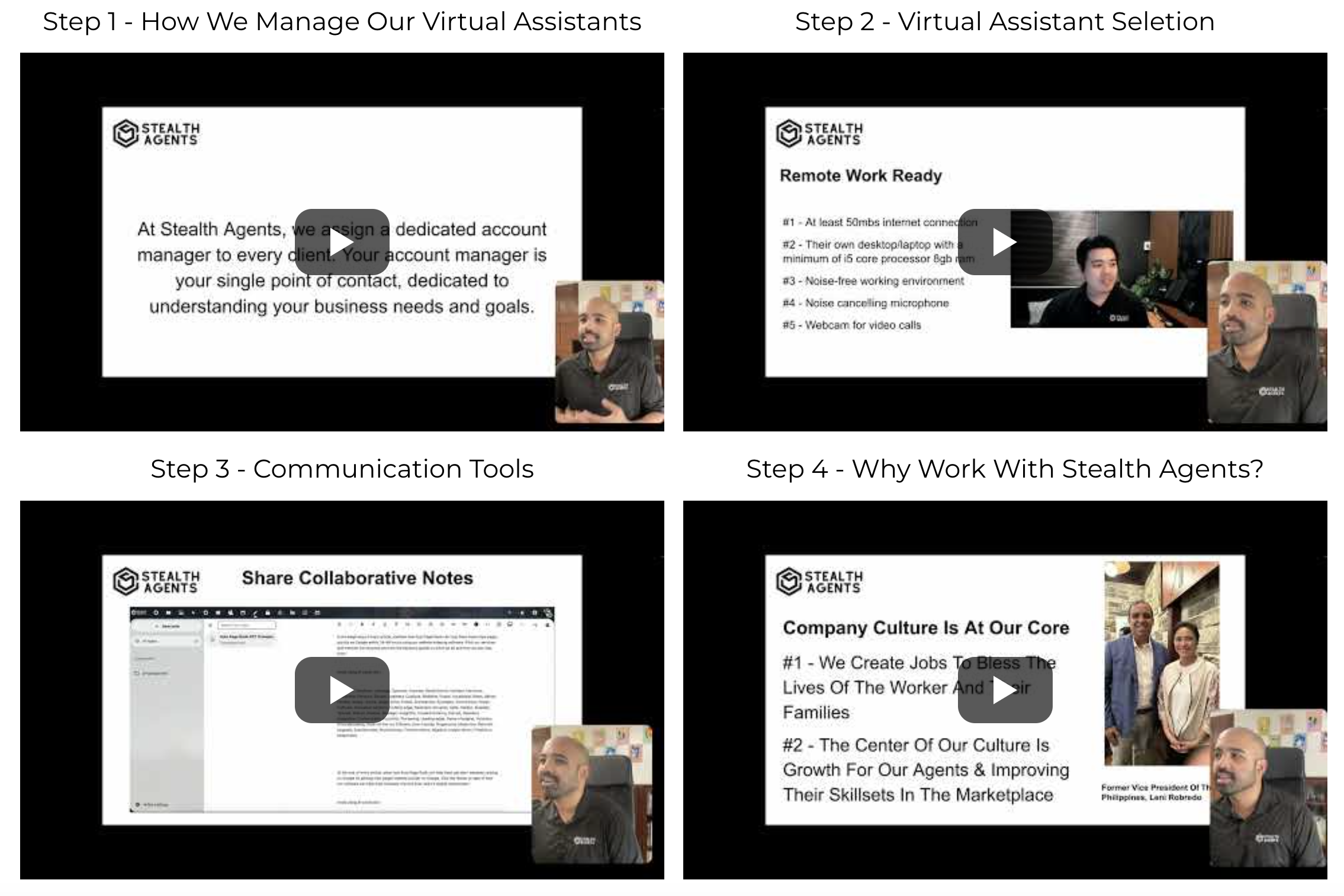Running a healthcare organization at the C-suite level involves endless tasks and responsibilities that often feel unmanageable.
The workload can be overwhelming, from coordinating schedules to managing data and ensuring daily operations run smoothly.
Outsourcing C-suite healthcare services could be the strategic choice to save time, reduce costs, and focus on critical decision-making. Stealth Agents provides reliable virtual assistant tailored to healthcare executives’ unique needs.
Studies have shown that outsourcing can cut operational expenses by up to 78%, leaving more room for growth and strategic initiatives.
Stop letting administrative duties pull your focus from high-impact leadership. Book a free consultation now to discover how our services and virtual assistant pricing can help lighten your load and keep your organization thriving.
What Is C-Suite Healthcare Outsourcing?
C-suite healthcare outsourcing involves delegating high-level administrative and operational tasks to specialized professionals, ensuring healthcare organizations maintain focus on patient care.
By outsourcing responsibilities tied to the levels of executive assistants, organizations can efficiently handle scheduling, data management, and coordination within the executive team.
Studies show that effective delegation of tasks increases organizational productivity by up to 30%, reducing internal burdens. Outsourcing these roles allows healthcare leaders to access skilled assistants adept in managing complex project workflows and administrative functions.
Virtual professionals skilled in C-suite healthcare support also handle report preparation, email management, and executive correspondence with high accuracy and attention to detail.
This approach lowers overhead and ensures access to professionals with experience across various healthcare sectors. Organizations adopting outsourcing strategies report improved executive efficiency and alignment with their goals.
What Does a C-Suite Executive Do in the Healthcare Industry?
By overseeing important tasks and ensuring everything runs smoothly, C-suite executives significantly contribute to the development and success of the healthcare sector. Below are the top 10 core duties they handle.
1. Strategic Leadership
C-suite healthcare executives develop long-term strategies to drive organizational performance and ensure patient-centric care delivery. Hiring leaders with deep industry knowledge significantly improves decision-making outcomes.
Studies show that strategic oversight in healthcare improves operational efficiency by 25%.
These executives implement policies that align with market trends and regulatory requirements.
Their decisions impact how hospitals and clinics improve patient satisfaction and organizational growth.
A focus on achieving healthcare goals sustains financial stability and operational success. Strategic leadership ensures seamless coordination between various healthcare departments.
2. Financial Oversight
Chief executives supervise budgeting, revenue cycles, and funding strategies to maintain organizational stability.
Hospitals with efficient financial oversight report a 35% higher chance of meeting annual goals.
Effective resource management ensures compliance with financial regulations and sustainability.
C-suite executives analyze costing structures for improved service delivery and reduced expenses. This role ensures that healthcare organizations stay competitive while maintaining access to quality care.
Accurate financial planning supports robust investments in staff, technology, and infrastructure. Financial oversight preserves patient trust by ensuring billing transparency.
3. Patient Care Standards
Top executives play a pivotal role in establishing quality standards for patient care.
Studies reveal that executive involvement in care initiatives improves patient outcomes by 20%.
Leaders hire experts who introduce advanced treatments and ensure compliance with clinical guidelines. These executives emphasize training programs to keep staff updated on patient safety procedures.
Operational practices ensure all patients receive timely and effective treatment.
Enhancing care delivery standards builds a solid reputation in competitive healthcare markets. Executives monitor performance metrics to promote a culture of accountability across departments.
4. Technological Development
Healthcare companies are increasingly using technology to improve service delivery and lessen administrative workloads. C-suite executives invest in innovations like telemedicine and digital health tools for seamless patient care.
Hospitals incorporating technology from strong leadership report a 30% increase in patient satisfaction rates.
Leaders ensure data privacy and enforce systems that support secure recordkeeping.
C-suite healthcare executives also guide the integration of emerging technologies for streamlined diagnoses and treatments.
Hiring tech-savvy executives addresses the growing need for reliable medical data management. Implementing the right technology cultivates better workflow and reduces bottlenecks in critical care.
5. Workforce Development
Effective workforce administration is essential to maintain harmony among healthcare professionals and support staff.
Hospitals with strong leadership see a 40% annual reduction in employee turnover rates.
Leaders prioritize hiring specialized talent, ensuring high-quality care and organizational efficiency. Executives also focus on training initiatives that enhance workforce competencies.
Hiring programs carried out effectively boost employee satisfaction and performance.
Workforce development initiatives foster relationships between teams and improve cross-functional collaboration. A well-structured workforce contributes to streamlined operations and better patient outcomes.
6. Crisis Management
C-suite executives guide healthcare institutions through critical challenges, ensuring uninterrupted service delivery.
Strong crisis management leadership can reduce patient care disruptions by 30% during emergencies.
Leaders develop contingency plans for handling unexpected operational or service issues. Healthcare executives oversee processes for disaster recovery and supply chain continuity.
They ensure clear communication between stakeholders to mitigate potential risks.
Decisions from experienced executives ensure timely action and resolution without resource wastage. Effective crisis management enhances organizational resilience in unpredictable scenarios.
7. Regulatory Compliance
Navigating regulatory challenges in healthcare requires dedicated leadership to ensure smooth adherence to evolving policies.
Executives enforce compliance with regulations, decreasing financial risks and legal violations.
Hospitals with compliant frameworks report 25% fewer penalties annually. Leadership focuses on fostering a culture of accountability and transparency across departments.
Guidelines on documentation, procurement, and operational workflows come under executive oversight.
C-suite executives build partnerships with policymakers to stay updated on requirements and changes in healthcare laws. Regulatory compliance underpins patient safety and trust.
8. Community Partnerships
Building community partnerships is essential in addressing local healthcare challenges and promoting trust. Leaders focus on collaborations with local organizations and stakeholders to improve access to care.
These partnerships pave the way for collective responses to health emergencies and innovations in public health initiatives.
Programs designed through mutual efforts offer affordable, accessible care solutions.
Executives steer meaningful partnerships that effectively promote the organization’s mission.
Strengthening these relationships positively influences patient satisfaction and improves organization outreach initiatives. Partnerships ensure long-term sustainability for both hospitals and communities.
9. Coordination of Administrative Tasks
Administrative oversights like scheduling, patient communications, and supply management fall under the executive’s responsibilities. Virtual assistant healthcare scheduler services often streamline many of these day-to-day tasks.
Efficient administration ensures well-organized processes, reducing operational delays.
Leaders inherit the job of balancing staff workload to prevent employee burnout.
Hiring specialized coordinators, such as remote healthcare coordinator, helps manage complex systems.
Smooth administrative functions facilitate patient trust and quicker service delivery times. Improved coordination eliminates redundancies so that staff can focus entirely on caregiving.
10. Innovations in Patient Experience
Enhancing patient experience remains at the forefront of priorities for C-suite professionals.
Reports show that executive-driven initiatives improve patient feedback metrics by more than 35%.
Innovative solutions include shorter wait times, streamlined communication, or personalized care experiences.
Executives hire experts to research patient needs and implement data-driven insights. They focus on creating accessible, inclusive healthcare environments that meet diverse population needs.
Positive patient experiences build the credibility of healthcare organizations while attracting new partnerships. Leadership committed to patients fosters long-standing organizational values and success.
How Can Small Businesses Benefit From C-Suite Healthcare?
Small businesses can gain expert advice and guidance from C-suite healthcare, helping them make better decisions for their team’s well-being.
Studies show that companies with strong leadership see 25% more productivity, which benefits any small business aiming to grow.
A C-suite executive assistant can also help manage tasks so owners can focus on improving their products and serving customers.
When companies have access to experienced C-suite healthcare leaders, they can create healthier workplaces that draw in top talent.
By investing in professional care and strategy; small businesses build a stronger future while keeping their employees happy and healthy.
What Are the Key Responsibilities of C-Suite Healthcare Providers?
C-suite healthcare providers are critical in ensuring organizations run effectively and meet patient care goals. Here are their top responsibilities.
1. Leading Organizational Strategy
C-suite executives are responsible for developing and directing the healthcare organization’s overall strategy. They ensure goals align with patient care quality and compliance standards.
Approximately 87% of healthcare leaders prioritize patient safety in their organizational plans.
Strategic decision-making includes budgeting, workforce management, and long-term growth plans.
Effective leadership helps create a culture that supports innovation and collaboration.
C-suite healthcare executives also evaluate market trends to remain competitive in a constantly changing industry. Outsourcing specific operational functions can allow leaders to focus on core strategic responsibilities.
2. Overseeing Financial Management
Financial stability is crucial in healthcare, and executives ensure systems operate within budgets.
They manage expenses while prioritizing investments in medical technology and staff resources.
Reports show that 28% of healthcare costs are tied to administrative inefficiencies.
Accurate financial oversight reduces these risks and ensures sustainable operations. Executives collaborate with finance teams to meet revenue goals and allocate resources effectively.
Transparency in handling funds builds trust with both stakeholders and patients. A structured financial system fosters growth and safeguards organizational priorities.
3. Creating Operational Excellence
Efficient operations in patient flow, scheduling, and administrative tasks depend on focused leadership.
A virtual office manager for healthcare practice can enhance workflow by standardizing processes. C-suite leaders ensure every department collaborates effectively to minimize delays and improve efficiency.
Studies reveal that efficient systems improve patient satisfaction scores by over 25%.
Addressing system bottlenecks is a continuous task for healthcare leaders to maintain seamless care delivery.
Selecting reliable systems and integrating updated technologies reduces redundancies. Attention to operational details directly impacts how healthcare facilities meet patient needs.
4. Driving Workforce Development
Building and maintaining skilled staff teams is a significant responsibility within C-suite healthcare roles.
Effective leadership involves recruiting top talent and inspiring staff commitment to organizational goals.
Providing professional development opportunities increases employee retention, which is critical in a competitive job market.
Approximately 60% of employees report higher engagement when organizations invest in skills training. Executives establish initiatives to enhance job satisfaction and promote team collaboration.
Outsourcing non-core administrative tasks to experts like a remote healthcare coordinator can lessen staff burdens. Empowered employees deliver better patient outcomes and ensure operational success.
5. Ensuring Regulatory Compliance
Healthcare providers must adhere to stringent regulations, making compliance a key focus for executive leadership. Failure to meet standards can result in hefty fines or reputational damage.
Around 94% of hospitals report compliance as a top management concern.
C-suite leaders ensure every department meets federal and state healthcare requirements. Regular audits and proper documentation safeguard organizations from legal risks.
Training programs led by executives educate staff on compliance protocols and ethical guidelines.
Balancing patient care and regulatory compliance requires continuous attention and adaptive policies. Proper oversight ensures both safety and trust within the organization.
Why Choose Stealth Agents for C-Suite Healthcare Outsourcing?
Stealth Agents is the trusted choice for C-suite healthcare outsourcing, providing expert assistance to meet the unique demands of the healthcare industry.
Their team focuses on delivering high-quality executive support, ensuring critical tasks like scheduling, data management, and communications run seamlessly.
Remote work trends have shown virtual assistants to be indispensable, with demand increasing as healthcare organizations aim to maintain operational efficiency.
Outsourcing with Stealth Agents allows healthcare providers to reduce administrative burdens while saving up to 70% on staffing costs.
Their expertise ensures precision in handling sensitive healthcare information and compliance with industry regulations, giving healthcare executives peace of mind.
Organizations can access a skilled workforce ready to handle complex C-suite healthcare responsibilities professionally by choosing Stealth Agents.
This approach streamlines workflows and empowers companies to focus more on delivering superior patient care and achieving long-term goals.
Takeaways
Outsourcing your business needs in the world of C-suite healthcare doesn’t just save money—it drives more intelligent operations.
By entrusting routine tasks to experienced virtual assistants, you free up valuable time to focus on core strategies and decision-making.
Virtual assistants with over 10 years of expertise bring precision, dedication, and reliability to the table, making your workload lighter and your outcomes stronger.
With the proper support, achieving efficiency and reducing overhead costs is no longer a challenge but a reality.
Start today with Stealth Agents’ virtual assistants, with rates starting at just $15 per hour, no part-time commitments, and the expertise you can trust to transform your business workflow.












